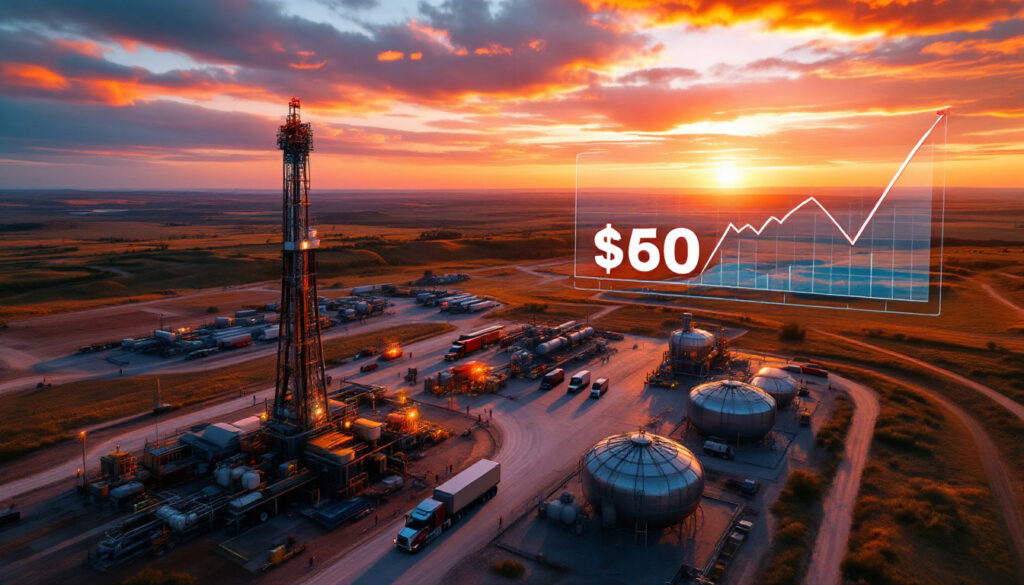Understanding Liberty Energy's Outlook on US Oil Prices
In the volatile world of oil markets, key industry players like Liberty Energy provide crucial insights into production sustainability thresholds. As one of America's largest fracking service providers, Liberty's perspective offers valuable guidance on where U.S. oil production might be heading in response to price fluctuations. Understanding these market dynamics explained is essential for investors tracking the energy sector.
Liberty Energy CEO Ron Gusek has established a clear price threshold for maintaining current operational activity. In recent industry communications, Gusek indicated that oil prices in the low $60s per barrel represent a critical psychological and economic boundary for the sector. While these prices aren't considered robust by historical standards, they appear sufficient to sustain existing activity levels across major U.S. shale basins.
"If oil stayed in the low $60s, that would be enough to maintain the current level of activity, though it's not an exciting environment for us by any stretch of the imagination," noted Gusek during a recent investor call. This candid assessment reveals the challenging balance service companies must strike in today's energy landscape.
The company's market positioning gives significant weight to its outlook. As the third-largest fracking service provider with approximately 18% market share in the U.S., Liberty's operational insights reflect broader industry conditions across multiple basins and customer types.
How Does Liberty Energy View Current Oil Market Conditions?
Liberty Energy maintains a cautiously optimistic stance on current market conditions despite ongoing price volatility. The company's leadership team, including CEO Ron Gusek, has indicated that most oil producers are expected to maintain their established production plans if prices remain near current levels in the low-to-mid $60s per barrel.
This stability stems partially from Liberty's strategic hedging approach, with approximately 65% of its 2025 service contracts locked in above the $62 threshold. This buffer provides operational certainty even during temporary price dips, something the industry has learned to value following the extreme volatility of 2020.
When prices drop below the critical $60 threshold, Gusek anticipates only "modest ripples in activity levels" rather than dramatic operational shifts. This measured response demonstrates the increased resilience the fracking sector has developed in recent years, moving away from the boom-bust cycles that previously characterized the industry.
Liberty's Assessment of Price Thresholds
Liberty's analysis suggests that while $60 oil isn't ideal for aggressive growth, it provides sufficient margins for maintaining operational continuity. The company has developed sophisticated models for understanding how different price environments affect customer behavior across various basins.
Historical data supports this assessment. During a brief price collapse to $58 in early 2024, the industry experienced only a 7% reduction in activity levels, primarily through the postponement of marginal wells rather than wholesale drilling program cancellations.
Current Market Positioning
Liberty Energy's significant market position allows it to gauge industry sentiment with remarkable accuracy. With operations spanning the Permian, Eagle Ford, Bakken, and other major basins, the company maintains visibility into producer economics across diverse geological settings.
The company's quarterly operational analyses track critical metrics including frac spread deployment, proppant consumption rates, and completion efficiency gains. These indicators serve as early warning systems for potential shifts in producer behavior in response to price changes.
What Price Levels Drive US Oil Production Decisions?
The $60 per barrel threshold has emerged as a crucial inflection point for U.S. oil producers' capital allocation decisions. This price level represents more than just an accounting breakeven; it embodies a complex psychological threshold where producers feel confident enough to maintain existing development plans.
Industry research from the Dallas Federal Reserve Energy Survey indicates that approximately 74% of producers cite $60 as their primary "planning threshold" for budgeting purposes. Below this level, companies typically initiate a phased reassessment process rather than immediately cutting production.
Critical Price Thresholds for Production
Breakeven economics vary significantly across U.S. oil basins, creating a tiered response to price fluctuations. Current data suggests Permian Basin operations typically maintain profitability between $48-$54 per barrel, while the Bakken formation in North Dakota requires higher prices ranging from $56-$61 to justify new drilling.
These thresholds have improved substantially through technological advances. Automated rig systems have delivered approximately 15% in cost reductions since 2022, allowing producers to maintain profitability even as service costs have risen in other areas.
When prices fall below basin-specific thresholds for extended periods (typically more than 30 days), the industry has historically implemented approximately 12% reductions in capital expenditure plans. These adjustments typically target the least economic drilling locations first, preserving core development areas.
Economic Viability Considerations
The geology of different production regions plays a crucial role in determining economic viability at varying price points. Liberty Energy's operational data reveals that enhanced completion techniques have significantly improved initial production rates, particularly in the Delaware Basin portion of the Permian, where advanced proppant designs have boosted initial 30-day production by up to 25% compared to 2020 methods.
These technical improvements have counterbalanced inflationary pressures, including significant increases in steel costs for tubular goods (up 22% year-over-year) and rising labor costs in key production regions. The net effect has been relatively stable breakeven prices despite opposing economic forces.
How Do Oil Price Fluctuations Impact Fracking Operations?
The relationship between oil prices and fracking activity follows predictable patterns, though with important nuances that Liberty Energy has identified through years of operational data. The company's analysis indicates a strong correlation (0.89 R² value) between 90-day oil price averages and subsequent frac spread deployment.
This mathematical relationship demonstrates that service companies like Liberty respond to sustained price trends rather than short-term fluctuations. The operational inertia of the fracking industry creates a natural buffer against price volatility.
Operational Response to Price Changes
Liberty Energy's operational data indicates a typical response lag of 6-8 weeks between price movements and significant adjustments to crew deployments. This deliberate approach prevents costly overreactions to temporary market conditions.
"We've built significant flexibility into our supply chain since 2020," explained Gusek in recent industry communications. This flexibility includes modular equipment configurations that can be rapidly redeployed between basins as economic conditions shift.
The company's historical data demonstrates this measured response pattern. During the fourth quarter of 2023, when oil prices surged temporarily to $75, the industry activated approximately 14% of previously idled frac spreads. However, these activations occurred only after prices had remained elevated for nearly two months.
Capital Expenditure Adjustments
Oil producers typically structure their capital expenditure reviews on quarterly cycles, with formal reassessments triggered by sustained price movements rather than daily fluctuations. According to Liberty's market intelligence, most producers incorporate contingency provisions that outline specific steps to be taken if prices fall below established thresholds for predetermined periods.
Just-in-time supply chain innovations have reduced idle equipment costs by approximately 30% compared to pre-pandemic operations. This efficiency improvement allows service companies to maintain profitability even during periods of reduced utilization.
Liberty's operational data indicates that equipment utilization rates typically become the primary adjustment mechanism during price downturns. Rather than dramatically reducing active frac spread counts, companies often reduce the intensity of operations on existing equipment, extending maintenance intervals and optimizing deployment schedules.
What Factors Beyond Price Affect US Oil Production?
While price remains the dominant factor influencing production decisions, Liberty Energy's market analysis highlights several equally critical non-price factors that can significantly impact fracking operations and production outcomes. Some of these factors are addressed in recent global commodities insights reports.
Supply Chain and Workforce Considerations
Proppant (fracking sand) availability has emerged as a crucial constraint in certain operational scenarios. Liberty's supply chain executives have noted that sand logistics represent approximately 40% of completion costs, making this component as economically significant as oil prices in certain scenarios.
As Liberty's Vice President of Supply Chain recently observed, "Sand availability trumps short-term price moves in many operational scenarios." This reality was dramatically demonstrated during the 2024 Texas freeze event, which caused approximately 19% frac crew downtime despite stable oil prices, due primarily to logistics disruptions.
Workforce retention presents another critical non-price challenge. The industry's cyclical history has created lingering hesitancy among potential workers, leading Liberty and other service providers to implement cross-training programs and retention incentives that help maintain operational continuity regardless of price fluctuations.
Regulatory and Market Access Factors
Pipeline takeaway capacity continues to influence regional production decisions independently of oil prices. Current data indicates the Permian Basin enjoys approximately 600,000 barrels per day of surplus takeaway capacity, creating favorable economics for continued development regardless of moderate price fluctuations.
Regulatory permitting timelines represent another non-price factor with significant operational implications. Average permit approval times have improved significantly, dropping from 41 days in 2020 to approximately 27 days in 2024. This efficiency gain allows producers to respond more quickly to favorable price environments when they emerge.
International market dynamics, particularly LNG export policies and global demand patterns, increasingly influence domestic producer decisions beyond simple WTI price considerations. The growing interconnection between natural gas and oil production economics (particularly in associated gas regions) means that changes in global gas markets can impact oil production economics. Trump's energy policies also continue to influence market expectations according to recent industry predictions for 2025.
FAQ: Liberty Energy and US Oil Production
What is Liberty Energy's position in the US oil services market?
Liberty Energy ranks as the third-largest U.S. fracking service provider with approximately 18% market share. The company operates across all major U.S. shale basins, providing critical well completion services including hydraulic fracturing, wireline operations, and related technologies. This broad market presence gives Liberty comprehensive visibility into production economics across diverse geological settings.
How do oil prices affect fracking activity levels?
According to Liberty Energy's operational data and CEO statements, prices above $60 per barrel generally support stable activity levels across most U.S. basins. The company's analysis identifies a strong correlation (0.89 R² value) between 90-day average oil prices and subsequent frac spread deployment, with a typical 6-8 week lag between price movements and operational adjustments.
What makes the current oil price environment challenging?
Liberty's leadership team characterizes prices in the low $60s as "not exciting," reflecting the challenging reality that while these prices maintain existing operations, they don't generate sufficient margins to stimulate significant growth in activity levels. This equilibrium state creates pressure to maximize operational efficiency while waiting for more favorable pricing conditions to emerge.
How quickly do service companies like Liberty respond to oil price changes?
The reference to "modest ripples in activity levels" indicates that service companies have developed sophisticated response mechanisms that prioritize operational stability. Liberty typically maintains a 6-8 week evaluation period before making significant deployment changes, focusing first on utilization optimization before adding or removing equipment from active service.
What metrics should investors monitor regarding US oil production?
Key indicators for understanding production trends include standard measures like rig counts and well completion rates, but Liberty's analysis suggests additional metrics provide earlier warning signals. These include proppant consumption rates, frac stage counts per crew, and drilled-but-uncompleted (DUC) well inventory changes. Monitoring capital expenditure announcements from major producers provides insight into longer-term trends. For those interested in investing, a comprehensive mining stocks guide can provide valuable context.
How do geological differences impact production economics across different basins?
Basin-specific geology creates significant variability in breakeven prices. Current data indicates Permian operations typically maintain profitability between $48-$54 per barrel, while Bakken formations require $56-$61 prices. These differences result from variations in reservoir quality, production decline curves, and completion requirements, with technological improvements continually reducing these thresholds in most regions.
Disclaimer: This article contains analysis based on current market conditions and industry statements. Oil markets are inherently volatile, and future conditions may differ significantly from current projections. Readers should consult with financial advisors before making investment decisions based on this information.
Want to Stay Ahead of the Next Major ASX Mining Discovery?
Discovery Alert's proprietary Discovery IQ model delivers instant notifications when significant mineral discoveries are announced on the ASX, giving you the market edge before prices surge. Explore how historic discoveries have generated substantial returns by visiting the Discovery Alert discoveries page and begin your 30-day free trial today.




